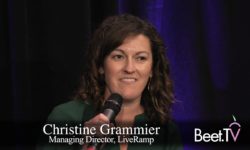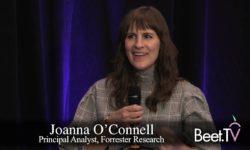It’s not an exaggeration to compare the current state of TV measurement to a “Game of Thrones”-like scenario, according to Nicole Whitesel, the evp of advanced TV at Publicis Media.
During a fireside chat with Jon Watts, co-founder and managing partner at MTM London at the Beet Retreat, hosted by Publicis Media, Whitesel explained why clients are “terrified” of current measurement strategies across linear TV, data-driven linear TV and advanced TV, mainly because multiple partners and approaches are required to get a clear picture of what’s driving results.
“We are in the Wild West. There are clients depending on the metrics and business goals. We could spend a day on TV measurement,” says Whitesel. “There’s a huge issue when it comes to TV measurement with a digital mindset, where people are like ‘Just give me exposure data and I’ll make decisions based on that.’ Thats a huge issue. If you do that you can run yourself right out of TV.”
Whitesel’s concern is that a singular view of data will mislead advertisers into ignoring some channels and spending more on others because of a lack of transparency across mediums. As advanced TV rises and linear TV changes, Whitesel is observing big shifts in the industry. Here are her biggest takeaways.
For advertisers, TV is a spectrum.
Whitesel says there’s still a misunderstanding about what advanced TV actually is – the conclusion is that it’s all OTT, CTV and one-to-one addressable TV. But there are more opportunities that get overlooked that fall between linear and hyper-targeted addressable TV, including data-driven linear, which helps brands make the most of big TV moments with the most reach, like the Super Bowl, while still collecting information on audience and lift.
“We have to understand that not all [channels] are equal across and they all contribute in different ways to different outcomes for brands and clients, and that’s the gap.”
Frequency remains the biggest issue for advanced TV.
Because transparency remains an issue for the advanced TV market, there’s a responsibility for agencies to improve the ability for clients to understand what they’re paying for and where it’s going, and tying that directly to business outcomes, whatever those may be. Those are going to be different for different companies, which is where multiple measurement partners come in.
“TV measurement is the great democratization we need to understand how each [of the channels] is tied to a business outcome at the client or brand level. Whether it’s retail store visits, website metrics, sales in aggregate – we need to get better about tying those things together, so we can deliver the right amount by channel for clients to deliver the best outcomes.”
Walled gardens come with both benefits and challenges.
Moving toward network and platform walled gardens, which Whitesel says some currently are but wouldn’t name names, would give advertisers more data and more transparency, because the data providers own the data. But that data comes at a cost.
“The cost is there of not seeing the rest of the universe, and there’s learnings where you’re not going to listen because you don’t have enough trust in the evaluation of the rest of the landscape,” says Whitesel. “What learnings can you get from the walled gardens without the cost of everything else?”
The next five years will be about content.
Whitesel’s prediction for the next five years in TV and advanced TV is that there will be a shift to control over content.
“There’s been a lot of disparate sources where you can buy audiences, through premium, TV-like content,” says Whitesel. “Now you’re starting to see the TV giants put their arms around that content, seeing how valuable it is and [wanting] better control of it regardless of where it’s being viewed. Owning that content and getting the exposure data is allowing for more insight.”
This video was produced at the Beet Retreat leadership event hosted Publicis Media in New York. The event and video series is sponsored by FreeWheel and LiveRamp. For more videos from the event, please visit this page.














































